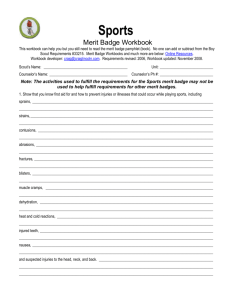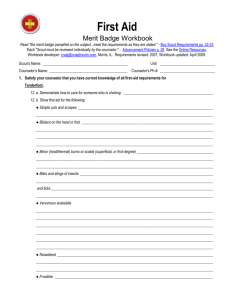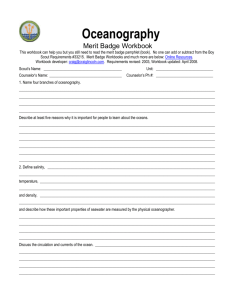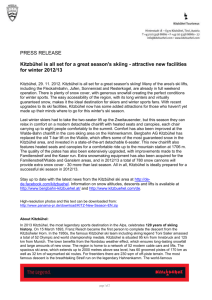Snow Sports Merit Badge Workbook for Boy Scouts
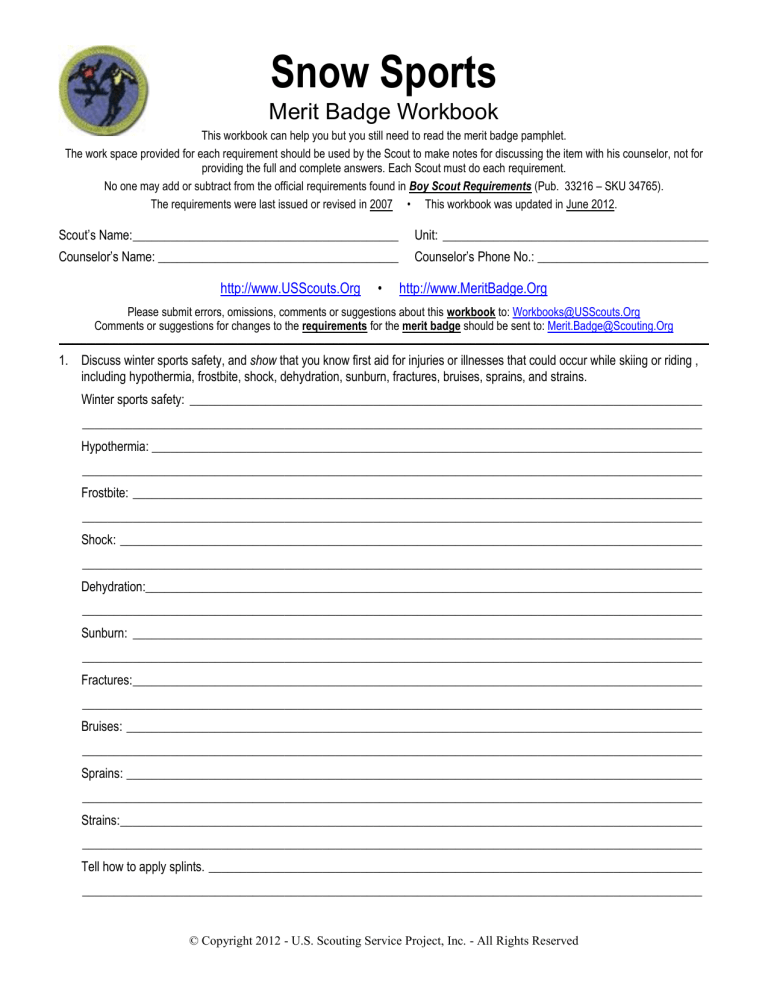
Snow Sports
Merit Badge Workbook
This workbook can help you but you still need to read the merit badge pamphlet.
The work space provided for each requirement should be used by the Scout to make notes for discussing the item with his counselor, not for providing the full and complete answers. Each Scout must do each requirement.
No one may add or subtract from the official requirements found in Boy Scout Requirements (Pub. 33216 – SKU 34765).
The requirements were last issued or revised in 2007 • This workbook was updated in June 2012.
Scout’s Name: __________________________________________ Unit: __________________________________________
Counselor’s Name: ______________________________________ Counselor’s Phone No.: ___________________________
http://www.USScouts.Org
•
http://www.MeritBadge.Org
Please submit errors, omissions, comments or suggestions about this workbook to: Workbooks@USScouts.Org
Comments or suggestions for changes to the requirements for the merit badge should be sent to: Merit.Badge@Scouting.Org
______________________________________________________________________________________________________________________________________________
1. Discuss winter sports safety, and show that you know first aid for injuries or illnesses that could occur while skiing or riding , including hypothermia, frostbite, shock, dehydration, sunburn, fractures, bruises, sprains, and strains.
Winter sports safety: _________________________________________________________________________________
__________________________________________________________________________________________________
Hypothermia: _______________________________________________________________________________________
__________________________________________________________________________________________________
Frostbite: __________________________________________________________________________________________
__________________________________________________________________________________________________
Shock: ____________________________________________________________________________________________
__________________________________________________________________________________________________
Dehydration:________________________________________________________________________________________
__________________________________________________________________________________________________
Sunburn: __________________________________________________________________________________________
__________________________________________________________________________________________________
Fractures: __________________________________________________________________________________________
__________________________________________________________________________________________________
Bruises: ___________________________________________________________________________________________
__________________________________________________________________________________________________
Sprains: ___________________________________________________________________________________________
__________________________________________________________________________________________________
Strains: ____________________________________________________________________________________________
__________________________________________________________________________________________________
Tell how to apply splints. ______________________________________________________________________________
__________________________________________________________________________________________________
© Copyright 2012 - U.S. Scouting Service Project, Inc. - All Rights Reserved
Snow Sports Scout's Name: ________________________
2. Explain why every skier or snowboarder should be prepared to render first aid in the event of an accident. ______________
__________________________________________________________________________________________________
__________________________________________________________________________________________________
__________________________________________________________________________________________________
3. Explain the procedure used to report an accident to the local ski patrol for the area where you usually ski or ride. _________
__________________________________________________________________________________________________
__________________________________________________________________________________________________
__________________________________________________________________________________________________
4. Do EACH of the following: a. Tell the meaning of the Your Responsibility Code for skiers and snow-boarders.
( A copy of Your Responsibility Code can be found at the end of this workbook.)
______________________________________________________________________________________________
______________________________________________________________________________________________
______________________________________________________________________________________________
______________________________________________________________________________________________
______________________________________________________________________________________________
______________________________________________________________________________________________
Explain why each rider must follow this code. __________________________________________________________
______________________________________________________________________________________________
______________________________________________________________________________________________
______________________________________________________________________________________________ b. Explain the Smart Style safety program.
( A copy of Smart Style can be found at the end of this workbook.) __________________________________________
______________________________________________________________________________________________
______________________________________________________________________________________________
______________________________________________________________________________________________
______________________________________________________________________________________________
Tell why it is important and how it applies to skiers and snowboarders in terrain parks and pipes. __________________
______________________________________________________________________________________________
______________________________________________________________________________________________
______________________________________________________________________________________________ c. Explain the precautions pertaining to avalanche safety, including the responsibility of individuals regarding avalanche safety. _________________________________________________________________________________________
______________________________________________________________________________________________
______________________________________________________________________________________________
Snow Sports - Merit Badge Workbook Page. 2 of 11
Snow Sports Scout's Name: ________________________
______________________________________________________________________________________________ d. Tell the meaning of the Wilderness Use Policy.
( A copy of the Wilderness Use Policy can be found at the end of this workbook.)
______________________________________________________________________________________________
______________________________________________________________________________________________
______________________________________________________________________________________________
______________________________________________________________________________________________
______________________________________________________________________________________________
Explain why each skier and snowboarder must adopt this policy.
______________________________________________________________________________________________
______________________________________________________________________________________________
______________________________________________________________________________________________
5. Complete all of the requirements for ONE of the following options: downhill (Alpine) skiing or cross-country (Nordic) or snowboarding.
Downhill (Alpine) Skiing Option a. Show how to use and maintain your own release bindings and explain the use of two others. __________________
___________________________________________________________________________________________
___________________________________________________________________________________________
___________________________________________________________________________________________
Explain the international DIN standard and what it means to skiers. ______________________________________
___________________________________________________________________________________________
___________________________________________________________________________________________
___________________________________________________________________________________________
___________________________________________________________________________________________ b. Explain the American Teaching System and a basic snow-skiing progression. _____________________________
___________________________________________________________________________________________
___________________________________________________________________________________________
___________________________________________________________________________________________
___________________________________________________________________________________________ c. Name the major ski organizations in the United States and explain their functions.
Organization Functions
________________________________ __________________________________________________________
________________________________ __________________________________________________________
________________________________ __________________________________________________________
________________________________ __________________________________________________________
________________________________ __________________________________________________________
Snow Sports - Merit Badge Workbook Page. 3 of 11
Snow Sports Scout's Name: ________________________
________________________________ __________________________________________________________ d. Discuss the five types of Alpine skis. Demonstrate two ways to carry skis and poles safely and easily.
_____________________ _____________________________________________________________________
_____________________ _____________________________________________________________________
_____________________ _____________________________________________________________________
_____________________ _____________________________________________________________________
_____________________ _____________________________________________________________________ e. Explain the importance of strength, endurance, and flexibility in downhill skiing.
Strength: ___________________________________________________________________________________
___________________________________________________________________________________________
Endurance: _________________________________________________________________________________
___________________________________________________________________________________________
Flexibility: ___________________________________________________________________________________
___________________________________________________________________________________________
Demonstrate exercises and activities you can do to get fit for skiing. _____________________________________
___________________________________________________________________________________________
___________________________________________________________________________________________
f. Present yourself properly clothed and equipped for downhill skiing.
Discuss how the clothing you have chosen will keep you warm and protected. _____________________________
___________________________________________________________________________________________
___________________________________________________________________________________________
___________________________________________________________________________________________
g. Demonstrate how to ride one kind of lift and explain how to ride two others. _______________________________
___________________________________________________________________________________________
___________________________________________________________________________________________ h. Explain the international trail-marking system. ______________________________________________________
___________________________________________________________________________________________
___________________________________________________________________________________________
___________________________________________________________________________________________
i. On a gentle slope, demonstrate some of the beginning maneuvers learned in skiing. Include the straight run, gliding wedge, wedge stop, sidestep, and herringbone maneuvers.
straight run
gliding wedge
wedge stop
sidestep
Snow Sports - Merit Badge Workbook Page. 4 of 11
Snow Sports
herringbone
Scout's Name: ________________________
j. On slightly steeper terrain, show linked wedge turns.
k. On a moderate slope, demonstrate five to 10 christies.
l. Make a controlled run down an intermediate slope and demonstrate the following:
1. Short-, medium-, and long-radius parallel turns
2. A sideslip and safety (hockey) stop to each side
3. Traverse across a slope
m. Demonstrate the ability to ski in varied conditions, including changes in pitch, snow conditions, and moguls.
Maintain your balance and ability to turn.
Cross-Country (Nordic) Skiing Option
a. Show your ability to select, use, and repair, if necessary, the correct equipment for ski touring in safety and comfort. b. Discuss classical and telemark skis. ______________________________________________________________
Classical: ___________________________________________________________________________________
___________________________________________________________________________________________
Telemark: ___________________________________________________________________________________
___________________________________________________________________________________________
Demonstrate two ways to carry skis safely and easily. c. Discuss the basic principles of waxing for cross-country ski touring. _____________________________________
___________________________________________________________________________________________
___________________________________________________________________________________________ d. Discuss the differences between cross-country skiing, ski touring, ski mountaineering, downhill skiing.
Cross-country skiing: __________________________________________________________________________
___________________________________________________________________________________________
Ski touring: __________________________________________________________________________________
___________________________________________________________________________________________
Ski mountaineering: ___________________________________________________________________________
___________________________________________________________________________________________
Downhill skiing: ______________________________________________________________________________
___________________________________________________________________________________________ e. Explain the importance of strength, endurance, and flexibility in cross-country skiing. ________________________
___________________________________________________________________________________________
___________________________________________________________________________________________
___________________________________________________________________________________________
___________________________________________________________________________________________
___________________________________________________________________________________________
Snow Sports - Merit Badge Workbook Page. 5 of 11
Snow Sports
Scout's Name: ________________________
Demonstrate exercises and activities you can do to get fit for skiing. f. List items you would take on a one-day ski tour.
_______________________________ _______________________________
_______________________
_______________________________ _______________________________
_______________________
_______________________________ _______________________________
_______________________
_______________________________ _______________________________
_______________________
_______________________________ _______________________________
_______________________
g. Present yourself properly clothed and equipped for a one-day ski tour.
Discuss the correct use of your clothing and equipment , and how the clothing you have chosen will keep you warm and protected. _______________________________________________________________________________
___________________________________________________________________________________________
___________________________________________________________________________________________
___________________________________________________________________________________________
___________________________________________________________________________________________
___________________________________________________________________________________________
___________________________________________________________________________________________
h. Demonstrate the proper use of a topographic map and compass.
i. Show a degree of stamina that will enable you to keep up with an average ski-touring group your age. j. On a gentle, packed slope, show some basic ways to control speed and direction. Include the straight run, traverse, sideslip, step turn, wedge stop, and wedge turn maneuvers.
straight run
traverse
sideslip
step turn
wedge stop
wedge turn
k. On a cross-country trail, demonstrate effective propulsion by showing proper weight transfer from ski to ski, pole timing, rhythm, flow, and glide.
l. Demonstrate your ability, on a tour, to cope with an average variety of snow conditions. m. Demonstrate several methods of dealing with steep hills or difficult conditions. Include traverses and kick turns going uphill and downhill, sidesteps, pole drag, and ski-pole "glissade."
traverses going uphill
traverses going downhill
kick turns going uphill
kick turns going downhill
sidesteps
pole drag
Snow Sports - Merit Badge Workbook Page. 6 of 11
Snow Sports
ski-pole "glissade."
Scout's Name: ________________________
Snowboarding Option a. Discuss forward-fall injuries. ____________________________________________________________________
___________________________________________________________________________________________
Tell about prevention and what action must be taken in the event of any type of injury or accident. _____________
___________________________________________________________________________________________
___________________________________________________________________________________________
___________________________________________________________________________________________ b. Do the following:
1. Demonstrate your ability to select the correct equipment for snowboarding and to use it for safety and comfort.
2. Present yourself properly clothed and equipped for snowboarding.
Discuss how the clothing you have chosen will keep you warm and protected. ______________________
___________________________________________________________________________________
___________________________________________________________________________________
___________________________________________________________________________________ c. Show how to use and maintain your own bindings, and explain the use of the different binding methods. Explain the need for leashes. _____________________________________________________________________________
___________________________________________________________________________________________
___________________________________________________________________________________________
___________________________________________________________________________________________ d. Discuss the four types of snowboards.
___________________________________________________________________________________________
___________________________________________________________________________________________
___________________________________________________________________________________________
___________________________________________________________________________________________
Demonstrate how to carry a snowboard easily and safely.
e. Demonstrate exercises and activities that will get you fit for snowboarding.
f. Demonstrate how to ride one kind of lift and explain how to ride two others. g. Explain the international trail-marking system. ______________________________________________________
___________________________________________________________________________________________
___________________________________________________________________________________________
___________________________________________________________________________________________
___________________________________________________________________________________________
___________________________________________________________________________________________
___________________________________________________________________________________________
Snow Sports - Merit Badge Workbook Page. 7 of 11
Snow Sports Scout's Name: ________________________
___________________________________________________________________________________________
h. Demonstrate the basic principles of waxing a snowboard. i. Do the following
1. On a gentle slope, demonstrate beginning snowboarding maneuvers. Show basic ways to control speed and direction. Include the sideslipping maneuver.
2. On slightly steeper terrain, show traversing. j. On a moderate slope, demonstrate an ollie, a nose-end grab, and a wheelie.
Ollie
N ose-end grab
W heelie k. Make a controlled run down an intermediate slope and demonstrate the following:
1. Skidded, carved, and jump turns
2. Stops
3. Riding fakie
l. Demonstrate your ability to ride in varied conditions, including changes in pitch, snow conditions, and moguls.
Maintain your balance and ability to turn. m. Name the major snowboarding organizations in the United States and explain their functions.
Organization Functions
_____________________ _____________________________________________________________________
_____________________ _____________________________________________________________________
_____________________ _____________________________________________________________________
_____________________ _____________________________________________________________________
Requirement resources can be found here: http://www.meritbadge.org/wiki/index.php/Snow Sports#Requirement resources
Snow Sports - Merit Badge Workbook Page. 8 of 11
Snow Sports Scout's Name: ________________________
Your Responsibility Code
Skiing and snowboarding can be enjoyed in many ways. At areas you may see people using alpine skis, snowboards, telemark skis, cross country skis, and other specialized equipment, such as that used by the disabled. Regardless of how you decide to enjoy the slopes, always show courtesy to others and be aware that there are elements of risk in skiing that common sense and personal awareness can help reduce. Observe the code listed below and share with other skiers and riders the responsibility for a great skiing experience.
1. Always stay in control, and be able to stop or avoid other people or objects.
2. People ahead of you have the right of way. It is your responsibility to avoid them.
3. You must not stop where you obstruct a trail, or are not visible from above.
4. Whenever starting downhill or merging into a trail, look uphill and yield to others.
5. Always use devices to help prevent runaway equipment.
6. Observe all posted signs and warnings. Keep off closed trails and out of closed areas.
7. Prior to using any lift, you must have the knowledge and ability to load, ride and unload safely.
Know the code. It's your responsibility.
This is a partial list. Be safety conscious.
The Smart Style Program
There are four main messages that are associated with Smart Style:
1. MAKE A PLAN
Every time you use freestyle terrain, make a plan for each feature you want to use. Your speed, approach and take off will directly affect your maneuver and landing
2. LOOK BEFORE YOU LEAP
Scope around the jumps first, not over them. Know your landings are clear and clear yourself out of the landing area.
3. EASY STYLE IT
Start small and work your way up. (Inverted aerials not recommended).
4. RESPECT GETS RESPECT
From the lift line through the park.
The Principles of Leave No Trace
1. Plan Ahead and Prepare
2. Travel and Camp on Durable Surfaces
3. Dispose of Waste Properly (Pack It In, Pack It Out)
4. Leave What You Find
5. Minimize Campfire Impacts
6. Respect Wildlife
7. Be Considerate of Other Visitors
Snow Sports - Merit Badge Workbook
Outdoor Code
As an American, I will do my best to—
Be clean in my outdoor manners. I will treat the outdoors as a heritage. I will take care of it for myself and others. I will keep my trash and garbage out of lakes, streams, fields, woods, and roadways.
Be careful with fire. I will prevent wildfire. I will build my fires only when and where they are appropriate. When I have finished using a fire, I will make sure it is cold out. I will leave a clean fire ring, or remove all evidence of my fire.
Be considerate in the outdoors. I will treat public and private property with respect. I will follow the principles of Leave No Trace for all outdoor activities.
Be conservation-minded. I will learn about and practice good conservation of soil, waters, forests, minerals, grasslands, wildlife, and energy. I will urge others to do the same.
Page. 9 of 11
Snow Sports Scout's Name: ________________________
Wilderness Use Policy of the Boy Scouts of America
All privately or publicly owned backcountry land and designated wildernesses are included in the term “wilderness areas” in this policy. The Outdoor Code of the Boy Scouts of America and the principles of Leave No Trace apply to outdoor behavior generally, but for treks into wilderness areas, minimum-impact camping methods must be used. Within the outdoor program of the Boy Scouts of America, there are many different camping-skill levels. Camping practices that are appropriate for day outings, long-term Scout camp, or short-term unit camping might not apply to wilderness areas. Wherever they go, Scouts need to adopt attitudes and patterns of behavior that respect the rights of others, including future generations, to enjoy the outdoors.
In wilderness areas, it is crucial to minimize human impact, particularly on fragile ecosystems such as mountains, lakes and streams, deserts, and seashores. Because our impact varies from one season of the year to the next, it becomes important for us to adjust to these changing conditions to avoid damaging the environment.
The Boy Scouts of America emphasizes these practices for all troops, teams, and crews planning to use wilderness areas:
Contact the landowner or land-managing agency (USDA Forest Service, National Park Service, Bureau of Land Management,
U.S. Fish and Wildlife Service, U.S. Army Corps of Engineers, state and private agencies, etc.) well before an outing to learn the regulations for that area, including group size limits, to obtain required permits and current maps, and to discuss ways
Scouts can fulfill the expectations of property owners or land managers.
Obtain a tour permit (available through local council service centers), meet all of its conditions, and carry it during the trip.
Review the appropriate BSA safety literature relating to planned activities. (See Safe Swim Defense, Safety Afloat, Climb On
Safely, and Trek Safely.) Also see the Guide to Safe Scouting on the BSA Web site at http://www.scouting.org/pubs/gss/toc.html
for more information on current BSA policies and procedures for ensuring safe activities, as well as the Fieldbook Web site at http://www.bsafieldbook.org
.
Match the ruggedness of high-adventure experiences to the skills, physical ability, and maturity of those taking part. Save rugged treks for older unit members who are more proficient and experienced in outdoor skills.
Conduct pretrip training for your group that stresses proper wilderness behavior, rules, and skills for all of the conditions that may be encountered, including lightning, missing person, wildfire, high winds, flooding, and emergency medical situations.
Participate in training in how to apply the principles of Leave No Trace, and be proficient and experienced in the leadership and skills required for treks into wilderness areas.
Adhere to the principles of Leave No Trace.
Snow Sports - Merit Badge Workbook Page. 10 of 11
Attachment – (NOTE: It is not necessary to print this page.)
Important excerpts from the ‘Guide To Advancement’ , No. 33088:
Effective January 1, 2012, the ‘Guide to Advancement’ (which replaced the publication ‘Advancement Committee Policies and Procedures’ ) is now the official Boy Scouts of America source on advancement policies and procedures.
[ Inside front cover, and 5.0.1.4 ] — Unauthorized Changes to Advancement Program
No council, committee, district, unit, or individual has the authority to add to, or subtract from, advancement requirements.
(There are limited exceptions relating only to youth members with disabilities. For details see section 10, “Advancement for Members
With Special Needs”.)
[ Inside front cover, and 7.0.1.1 ] — The ‘Guide to Safe Scouting’ Applies
Policies and procedures outlined in the ‘Guide to Safe Scouting’, No. 34416, apply to all BSA activities, including those related to advancement and Eagle Scout service projects. [Note: Always reference the online version, which is updated quarterly.]
[ 7.0.3.1 ] — The Buddy System and Certifying Completion
Youth members must not meet one-on-one with adults. Sessions with counselors must take place where others can view the interaction, or the Scout must have a buddy: a friend, parent, guardian, brother, sister, or other relative —or better yet, another Scout working on the same badge— along with him attending the session. When the Scout meets with the counselor, he should bring any required projects. If these cannot be transported, he should present evidence, such as photographs or adult certification. His unit leader, for example, might state that a satisfactory bridge or tower has been built for the Pioneering merit badge, or that meals were prepared for Cooking. If there are questions that requirements were met, a counselor may confirm with adults involved. Once satisfied, the counselor signs the blue card using the date upon which the Scout completed the requirements, or in the case of partials, initials the individual requirements passed.
[ 7.0.3.2 ] — Group Instruction
It is acceptable—and sometimes desirable—for merit badges to be taught in group settings. This often occurs at camp and merit badge midways or similar events. Interactive group discussions can support learning. The method can also be attractive to “guest experts” assisting registered and approved counselors. Slide shows, skits, demonstrations, panels, and various other techniques can also be employed, but as any teacher can attest, not everyone will learn all the material.
There must be attention to each individual’s projects and his fulfillment of all requirements. We must know that every Scout — actually and personally — completed them. If, for example, a requirement uses words like “show,” “demonstrate,” or “discuss,” then every Scout must do that. It is unacceptable to award badges on the basis of sitting in classrooms watching demonstrations, or remaining silent during discussions. Because of the importance of individual attention in the merit badge plan, group instruction should be limited to those scenarios where the benefits are compelling.
[ 7.0.3.3 ] — Partial Completions
Scouts need not pass all requirements with one counselor. The Application for Merit Badge has a place to record what has been finished — a “partial.” In the center section on the reverse of the blue card, the counselor initials for each requirement passed. In the case of a partial completion, he or she does not retain the counselor’s portion of the card. A subsequent counselor may choose not to accept partial work, but this should be rare. A Scout, if he believes he is being treated unfairly, may work with his Scoutmaster to find another counselor. An example for the use of a signed partial would be to take it to camp as proof of prerequisites. Partials have no expiration except the 18th birthday.
Page. 11 of 11
